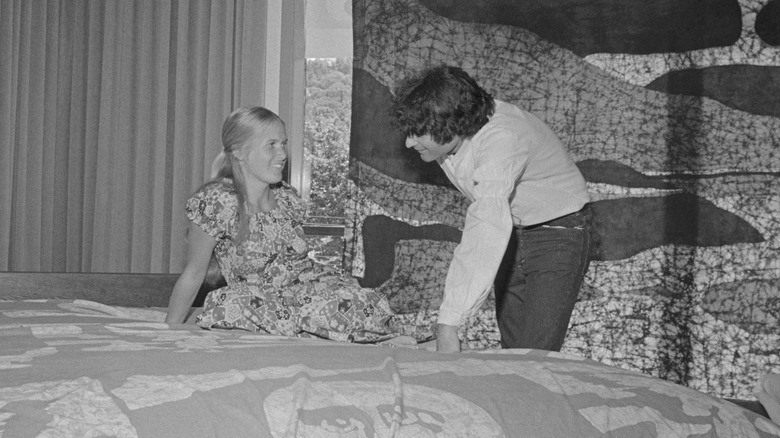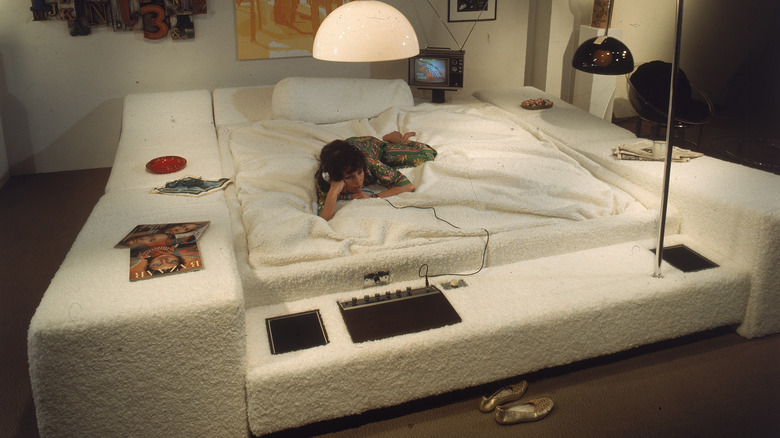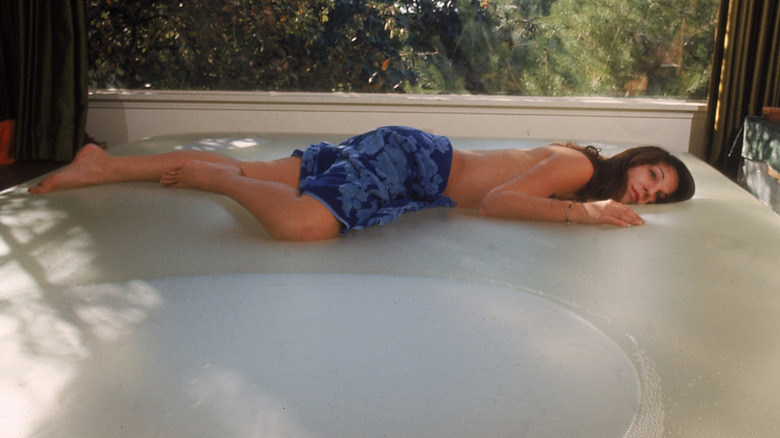Whatever Happened To Waterbeds?
Ever heard of a bed filled with Jell-O? If modern waterbed inventor Charles Hall's initial idea worked out, then you might have. (Perhaps not unexpectedly, the Jell-O molded.) Luckily, Hall's other concept turned out much better: The waterbed, essentially a bed-sized bag filled with hundreds of gallons of temperature-controlled H20, covered in liners, pads, blankets, and sheets. Hall developed what we now think of as a waterbed at San Francisco State University in the late 1960s as a master's thesis project, and once patented, they were a hit. Waterbeds are far less common today than they once were, but they're still sold — proving that while may be out of style, their story is far from over.
Hall's waterbed design wasn't exactly new. Sci-fi writer Robert Heinlein described something like it in the 1940s and '50s, and in the 19th century Dr. Neil Arnott wrote about what he called a "hydrostatic bed for invalids" in the London Medical and Surgical Journal. In the groovy 1970s and '80s, though, consumers liked the sensual experience of sleeping on Hall's version. Reportedly, Playboy founder Hugh Hefner even had one covered with Tasmanian opossum fur. In 2013, however, the Sioux City Journal said waterbeds constituted less than 5% of the mattress industry — down from around 12 to 15% in 1986, as The New York Times reported that year. There were practical and aesthetic concerns, but waterbeds ultimately faded because some people simply didn't sleep very well on them.
The problem with waterbeds
In 1970, TIME reported on the relative comfort of sleeping on water. But waterbed inventor Charles Hall also mentioned a chief complaint for people who didn't like the sensation: water sloshes. "You can't fight the water, you have to go with it," Hall told the outlet. One former waterbed user told The New York Times in 1986 that she gave up on her waterbed, calling it "too squishy," and Amber Perry-Wetrosky told Sioux City Journal in 2013 that it aggravated her father's back problems. Still, many consumers found waterbeds a desirable sleeping experience, and early waterbed advertising was filled with innuendo about waterbed benefits for that other bedroom activity adults engage in.
Riding that wave of popularity, waterbed sales reached $13 million by 1971. Meanwhile, they were especially popular on college campuses (they never really caught on in New York City). But alongside complaints about comfort, other problems soon arose. As waterbeds made a splash in the market, there were spills and floods when filling them up and accidents while they were in use, sometimes while people were sleeping. Most waterbeds were also much heavier than an average bed — some weighed up to 1,600 pounds and were nearly impossible to move. Perhaps worst of all, if you fail to take care of it properly, algae might grow in the water.
Consumer mood changed, and so did waterbeds
By 1986, The New York Times reported a change in consumer mood about the product. That year, Alan Dundes, a professor of anthropology and folklore at the University of California at Berkeley told the outlet, "There is a shift away from the self-indulgence of the 1970's. ... [The waterbed would have] to undergo a metamorphosis and conform to an image of respectability in order to survive." That, combined with safety issues, led to an overall waterbed sales decline, not to mention they also got banned on several college campuses.
Nonetheless, waterbeds are still manufactured and sold today. But as Mental Floss noted in 2016, they're updated to address that sloshing issue, among other comfort features and ease-of-use changes. Overall, they're no longer big bags of water but a series of water-filled tubes. In 2010, one bed salesmen told The Atlantic that many of his customers still like the feel of a waterbed when they try one but still won't make the purchase "just because it's a waterbed."
Though waterbeds are still afloat, in the late 1960s, waterbed inventor Charles Hall could not have imagined what one of the biggest waterbed consumers might be as of 2023: dairy farms. According to DCC Waterbeds, manufacturer of the dual-chamber cow waterbed, sleeping on a specially-designed cow waterbed is good for a cow's health and wellbeing, especially their udders and knees. As a result, cows produce better milk.


